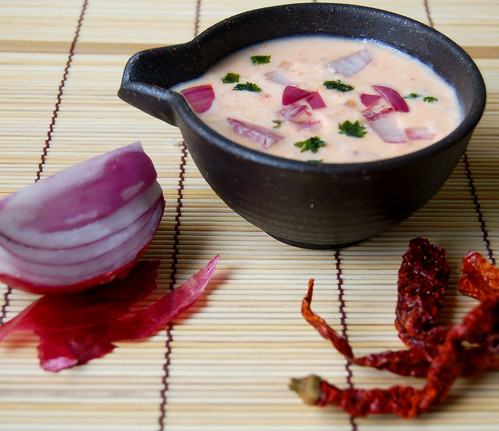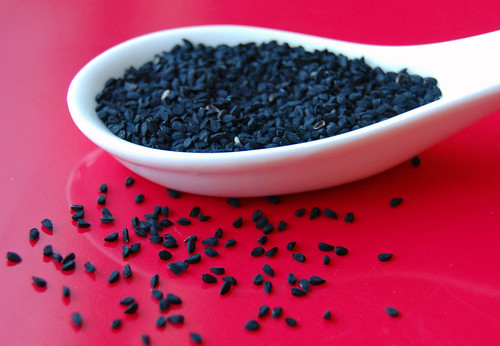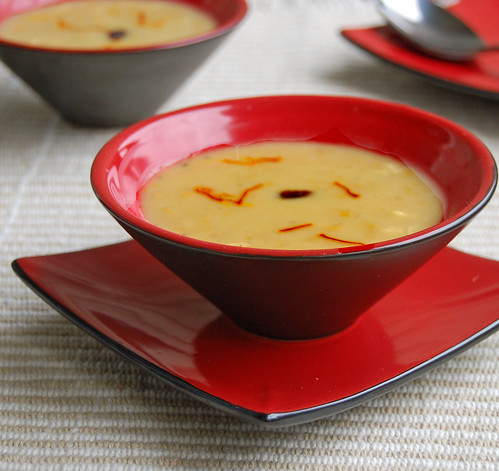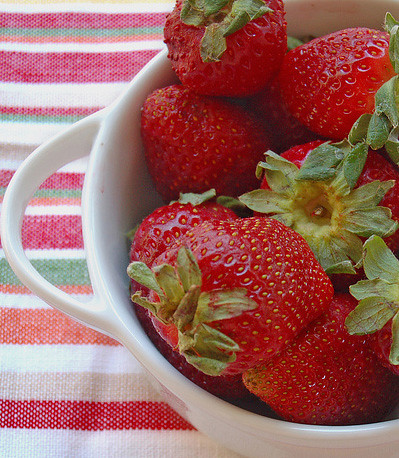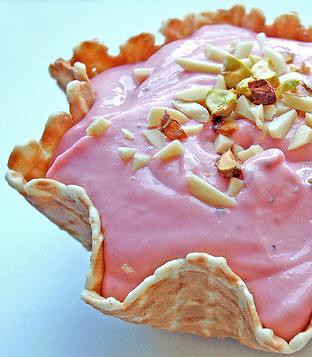Thursday
Tuesday
Blow hot, blow cold - Tambli
Quick, no fuss dinners have become the norm in my kitchen for the past few weeks (how I just hate it when life interferes with blogging :-)). Easily upping the cumin-pepper curry I posted last time is today's contribution - a) there is no cooking involved and b) do you really need a (b) when there is no cooking involved? Well then the curry is served cold. It can't get easier than this unless you order takeout!
Tamblis or tambolis are yogurt based curries that are a must during the hot summer months. They are made with a variety of ingredients, from the ever popular garlic, the curative asafoetida, to the seasonal greens available in the market.
What is Konkani food though if it doesn't push the flavor envelope?! Most everything we make is an unexpected combination of flavors; an "acquired taste". Here we are at it again, with a yogurt curry that is made with a base of onion and ginger. You need to have a pretty seasoned palate to enjoy this hot, cold blend!
ALLE KANDE TAMBLI (Ginger-onion Curry)
(serves 2)
1" piece of ginger (or enough for the curry to have a ginger-y punch)
3 tbsp fresh coconut, grated
1-2 dry red chillies
1 medium size onion, minced fine
1 cup yogurt, beaten or buttermilk
salt to taste
Grind ginger, coconut and chillies to a fine paste with a little water. If using yogurt, whisk with half a cup of water (or more to get desired consistency) and salt.
Add ground paste, mix well and chill until ready to serve. At the time of serving add minced onion. Serve cold with rice and fried fish or roasted papad.
If you are a highly conscientious cook who regards this no-cook curry as cheating, feel free to roast the chillies and ginger in a little ghee before grinding. BUT no matter how guilty you feel don't heat the tambli. It is served cold!!
* Leftovers can be used to make a chutney (add coconut to thicken the curry). Or add some boondi and chopped cilantro to make a raita.
* Other ideas for tambli - leaves of just about any vegetable (radish, beetroot, kohlrabi etc.)
Tamblis or tambolis are yogurt based curries that are a must during the hot summer months. They are made with a variety of ingredients, from the ever popular garlic, the curative asafoetida, to the seasonal greens available in the market.
What is Konkani food though if it doesn't push the flavor envelope?! Most everything we make is an unexpected combination of flavors; an "acquired taste". Here we are at it again, with a yogurt curry that is made with a base of onion and ginger. You need to have a pretty seasoned palate to enjoy this hot, cold blend!
ALLE KANDE TAMBLI (Ginger-onion Curry)
(serves 2)
1" piece of ginger (or enough for the curry to have a ginger-y punch)
3 tbsp fresh coconut, grated
1-2 dry red chillies
1 medium size onion, minced fine
1 cup yogurt, beaten or buttermilk
salt to taste
Grind ginger, coconut and chillies to a fine paste with a little water. If using yogurt, whisk with half a cup of water (or more to get desired consistency) and salt.
Add ground paste, mix well and chill until ready to serve. At the time of serving add minced onion. Serve cold with rice and fried fish or roasted papad.
If you are a highly conscientious cook who regards this no-cook curry as cheating, feel free to roast the chillies and ginger in a little ghee before grinding. BUT no matter how guilty you feel don't heat the tambli. It is served cold!!
* Leftovers can be used to make a chutney (add coconut to thicken the curry). Or add some boondi and chopped cilantro to make a raita.
* Other ideas for tambli - leaves of just about any vegetable (radish, beetroot, kohlrabi etc.)
Sunday
Nigella Awesome - Achaari Baingan
When I requested for more recipes using nigella seeds (kalonji) in my last post, I got responses from a few blog buddies and the idea for this informal event was born - Nigella Awesome (you can thank Vaishali for the pun on the domestic goddess).
If you have bought even the smallest packet of nigella seeds from your grocery store, chances are you still have a LOT of them lying in your pantry and not as many ideas what to do with them. If you don't have a packet of nigella seeds lying in your pantry, go out and buy one at once :-)
Though it is under appreciated in comparison to other seeds in the Indian spice box - mustard, cumin and fennel, those who use nigella will testify to its aromatic qualities. A little hot oil is all that's needed to coax it out of its shell, after that the seed will infuse your dish with a unique smoky, onion-y flavor.
A few of us are sharing our favorite recipes using this spice today. My contribution is Achaari Baingan, a recipe by Madhur Jaffrey. Achaari refers to cooking an ingredient with the same spices used in pickles - this dish is so good, it can convert even the odd soul who does not take to eggplant kindly.
* The original recipe calls for deep frying the eggplant slices. I used about 2-3 tablespoons of oil for each batch instead and they still tasted good.
ACHAARI BAINGAN (Eggplant in pickling style)
(adapted from Indian Cooking by Madhur Jaffrey)
(serves 2)
1 large eggplant
1 tsp ginger-garlic paste
1/2 tsp cumin seeds (optional, not in original recipe)
1 tsp fennel seeds
1/2 tsp nigella seeds (kalonji)
3 medium size tomatoes, finely chopped
1 tbsp coriander powder
a pinch of tumeric powder
1 tsp red chilli powder (or to your taste)
salt
oil for frying
Cut eggplant into largish cubes and place them in a bowl of cold water. Pat dry with a towel. Heat 2 tbsp oil in a deep saucepan. When hot, add the eggplant slices and fry them over medium heat until they turn reddish brown. Fry in batches if the saucepan cannot hold all slices at one time. Remove from heat and place on absorbent paper.
Add 1 tablespoon oil to the pan. When hot add cumin seeds; as they begin to sizzle, add fennel seeds and kalonji. When they darken add the chopped tomato and ginger-garlic paste. Stir for a minute. Add coriander, turmeric and chilli powder. Season with salt.
Mix well and and cook for about 2-3 minutes, breaking the tomato pieces with the back of your spoon. Turn the heat up and continue to stir until the masala thickens.
Add the eggplant slices in the sauce and mix gently. Cook for about a minute more. Serve hot with rotis.
Its a happy happy day for nigella! Check out -
Vaishali's Dal Fry
Krithika's Squash Subzi
Priya's Achaari Aloo, Naan and Namakparas
Nabeela's Khara Masala Chicken
Tags: indian recipe eggplant achari brinjal kalonji madhur jaffrey achaari
If you have bought even the smallest packet of nigella seeds from your grocery store, chances are you still have a LOT of them lying in your pantry and not as many ideas what to do with them. If you don't have a packet of nigella seeds lying in your pantry, go out and buy one at once :-)
Though it is under appreciated in comparison to other seeds in the Indian spice box - mustard, cumin and fennel, those who use nigella will testify to its aromatic qualities. A little hot oil is all that's needed to coax it out of its shell, after that the seed will infuse your dish with a unique smoky, onion-y flavor.
A few of us are sharing our favorite recipes using this spice today. My contribution is Achaari Baingan, a recipe by Madhur Jaffrey. Achaari refers to cooking an ingredient with the same spices used in pickles - this dish is so good, it can convert even the odd soul who does not take to eggplant kindly.
* The original recipe calls for deep frying the eggplant slices. I used about 2-3 tablespoons of oil for each batch instead and they still tasted good.
ACHAARI BAINGAN (Eggplant in pickling style)
(adapted from Indian Cooking by Madhur Jaffrey)
(serves 2)
1 large eggplant
1 tsp ginger-garlic paste
1/2 tsp cumin seeds (optional, not in original recipe)
1 tsp fennel seeds
1/2 tsp nigella seeds (kalonji)
3 medium size tomatoes, finely chopped
1 tbsp coriander powder
a pinch of tumeric powder
1 tsp red chilli powder (or to your taste)
salt
oil for frying
Cut eggplant into largish cubes and place them in a bowl of cold water. Pat dry with a towel. Heat 2 tbsp oil in a deep saucepan. When hot, add the eggplant slices and fry them over medium heat until they turn reddish brown. Fry in batches if the saucepan cannot hold all slices at one time. Remove from heat and place on absorbent paper.
Add 1 tablespoon oil to the pan. When hot add cumin seeds; as they begin to sizzle, add fennel seeds and kalonji. When they darken add the chopped tomato and ginger-garlic paste. Stir for a minute. Add coriander, turmeric and chilli powder. Season with salt.
Mix well and and cook for about 2-3 minutes, breaking the tomato pieces with the back of your spoon. Turn the heat up and continue to stir until the masala thickens.
Add the eggplant slices in the sauce and mix gently. Cook for about a minute more. Serve hot with rotis.
Its a happy happy day for nigella! Check out -
Vaishali's Dal Fry
Krithika's Squash Subzi
Priya's Achaari Aloo, Naan and Namakparas
Nabeela's Khara Masala Chicken
Tags: indian recipe eggplant achari brinjal kalonji madhur jaffrey achaari
Thursday
Mistress of Spices, finally
I am so late to this event I think Mythili might have forgotten she hosted this one! Well things have been really busy so expect to see that excuse for a few weeks more until I can get back on track.
As promised to my blog buddy though here is my write up on nigella seeds (kalonji). Not my first choice or my tenth for that matter, but by the time I got around to writing this, most spices I knew and used in my kitchen had already been well researched by my fellow bloggers. Which is why I chose kalonji - I am not too familiar with it and I thought it would be fun to learn more in the process.
Identity Crisis -
I always thought kalonji were onion seeds and have come across recipes that use the two interchangeably. This is only because the seeds have a faint oniony smell; the two plants however have no botanical relation whatsoever! In fact nigella seeds rarely seem to be recognized for their own selves, instead mistaken for black sesame or cumin due to their appearance.
Whats in a name? -
The name of the seeds in most languages has a reference to the word 'black'. For instance,
Latin: nigella (niger)
Hindi: kalonji (kala)
Italian: grano nero (nero)
Arabic: kamun aswad (aswad)
In the kitchen or in the cupboard! -
Nigella appears to have originated in Asia and come to India through Iran. It is most popular in North Indian cuisine, particularly Punjabi. The seeds are not very aromatic and develop a slight smoky flavor only when toasted or fried in oil. In Bengali cuisine nigella seeds are sometimes used in the paanch phoron (five spice mix) along with fenugreek, cumin, mustard seeds and fennel.
The sole dish that I make using these seeds is Achaari Baingan, where eggplants are cooked in a pickle masala. Other than this I have seen them sprinkled on naan.
The seeds are used to cure a variety of ailments; from indigestion to asthma. Nigella oil, known as blackseed oil contains antioxidants and is used in natural remedies. And if this is not enough, you can use the seeds as insect repellants or moth balls! Now isn't that really versatile for a spice which is not even recognized accurately?!
PS - It'd be good to know more recipes that use kalonji. So if you have any do share them with me.
As promised to my blog buddy though here is my write up on nigella seeds (kalonji). Not my first choice or my tenth for that matter, but by the time I got around to writing this, most spices I knew and used in my kitchen had already been well researched by my fellow bloggers. Which is why I chose kalonji - I am not too familiar with it and I thought it would be fun to learn more in the process.
Identity Crisis -
I always thought kalonji were onion seeds and have come across recipes that use the two interchangeably. This is only because the seeds have a faint oniony smell; the two plants however have no botanical relation whatsoever! In fact nigella seeds rarely seem to be recognized for their own selves, instead mistaken for black sesame or cumin due to their appearance.
Whats in a name? -
The name of the seeds in most languages has a reference to the word 'black'. For instance,
Latin: nigella (niger)
Hindi: kalonji (kala)
Italian: grano nero (nero)
Arabic: kamun aswad (aswad)
In the kitchen or in the cupboard! -
Nigella appears to have originated in Asia and come to India through Iran. It is most popular in North Indian cuisine, particularly Punjabi. The seeds are not very aromatic and develop a slight smoky flavor only when toasted or fried in oil. In Bengali cuisine nigella seeds are sometimes used in the paanch phoron (five spice mix) along with fenugreek, cumin, mustard seeds and fennel.
The sole dish that I make using these seeds is Achaari Baingan, where eggplants are cooked in a pickle masala. Other than this I have seen them sprinkled on naan.
The seeds are used to cure a variety of ailments; from indigestion to asthma. Nigella oil, known as blackseed oil contains antioxidants and is used in natural remedies. And if this is not enough, you can use the seeds as insect repellants or moth balls! Now isn't that really versatile for a spice which is not even recognized accurately?!
PS - It'd be good to know more recipes that use kalonji. So if you have any do share them with me.
Saturday
The Lentil Challenge - Madgane
We have lentil based breakfasts, we have lentil based snacks and of course we have lentil based curries. So when Catherine invited me to the lentil challenge hosted by Something in Season, I was actually stumped because I had so, so many dishes to choose from! "How about a lentil based dessert"?, I thought. Yes, why not, because we have those too.
Unlike popular Indian desserts, most Konkani desserts are not dairy-based. While the use of coconut, jaggery and cardamom is a given, they are usually combined with fruits, rice or lentils. Madgane is not a dessert in the traditional sense. We don't make it as a last course to a Sunday lunch for instance. It has rather richer associations - weddings, the Hindu New year and for me 'devasthan jewan' (meals eaten in a temple).
During the festival at our temple in Goa, after the puja was done, we would race to the lunch area a little distance away. This was not because we were very hungry (well not always) but because the road was blistering hot under the afternoon sun and we were barefoot. The entire lunch was delicious of course, but in my eyes it was the madgane that truly made the hotfooting (pun totally intended :-)) worthwhile.
Madgane is quite rich because it is made with a lot of coconut milk. I have reduced the amounts keeping in mind that I have indulged my sweet tooth a little too often in the past few weeks! I used a readymade tin of coconut milk; this obviously won't taste the same as freshly extracted milk but it sure cuts down the hassle and time.
MADGANE (Lentil Pudding)
(serves 2-3)
1/3 cup split bengal gram (chana dal)
6-8 cashews, halved
1/2 cup grated jaggery (adjust to taste)
1 cup coconut milk
1/2 tsp cardamom powder
Wash dal in 2-3 changes of water. Drain, then add about a cup of water and soak along with cashews for an hour.
Transfer to a deep bottom pan, add one more cup of water and cook until dal is tender. Do not overcook the dal; it should be soft but able to hold its shape. Add more water in batches if necessary.
Add jaggery, cardamom powder and milk. Bring to a boil over moderate heat. Serve hot.
(If the kheer is too watery add a tablespoon of rice flour to thicken it)
* Edited to add - I won!!! Thanks a lot Brendon.
Tags: indian dessert chana dal kheer payasam godshe mangannem
Unlike popular Indian desserts, most Konkani desserts are not dairy-based. While the use of coconut, jaggery and cardamom is a given, they are usually combined with fruits, rice or lentils. Madgane is not a dessert in the traditional sense. We don't make it as a last course to a Sunday lunch for instance. It has rather richer associations - weddings, the Hindu New year and for me 'devasthan jewan' (meals eaten in a temple).
During the festival at our temple in Goa, after the puja was done, we would race to the lunch area a little distance away. This was not because we were very hungry (well not always) but because the road was blistering hot under the afternoon sun and we were barefoot. The entire lunch was delicious of course, but in my eyes it was the madgane that truly made the hotfooting (pun totally intended :-)) worthwhile.
Madgane is quite rich because it is made with a lot of coconut milk. I have reduced the amounts keeping in mind that I have indulged my sweet tooth a little too often in the past few weeks! I used a readymade tin of coconut milk; this obviously won't taste the same as freshly extracted milk but it sure cuts down the hassle and time.
MADGANE (Lentil Pudding)
(serves 2-3)
1/3 cup split bengal gram (chana dal)
6-8 cashews, halved
1/2 cup grated jaggery (adjust to taste)
1 cup coconut milk
1/2 tsp cardamom powder
Wash dal in 2-3 changes of water. Drain, then add about a cup of water and soak along with cashews for an hour.
Transfer to a deep bottom pan, add one more cup of water and cook until dal is tender. Do not overcook the dal; it should be soft but able to hold its shape. Add more water in batches if necessary.
Add jaggery, cardamom powder and milk. Bring to a boil over moderate heat. Serve hot.
(If the kheer is too watery add a tablespoon of rice flour to thicken it)
* Edited to add - I won!!! Thanks a lot Brendon.
Tags: indian dessert chana dal kheer payasam godshe mangannem
Thursday
Jihva for Strawberries - Shrikhand
Inspiration didn't come as easily the second time around! I thought long and hard but couldn't narrow down on a strawberry dish that excited me enough. Cupcake, shortcake, mousse..... isn't there an Indian dessert with strawberries? Not really. It is an exotic fruit for us after all. In Bombay strawberries come to the market from Mahableshwar which is for that reason called the 'strawberry capital of Maharashtra'.
Go to the place at the right time and you can eat fresh strawberries straight off the farms; in fact you can satiate all your strawberry cravings if you so wish, because everyone in town seems to be selling strawberry milkshakes, fudge or jams.
Coming back to Jihva, I realized I didn't need to look far for ideas. Inspiration was right around the corner. Literally. For years folks in my parts of the city were loyal only to the original, saffron shrikhand; it took a while even for the mango version to gain access to the club (only because I suspect we knew mango went well with everything).
But then a new store opened in our neighbourhood, one so keen on "experimenting" that it introduced such mind boggling flavors as butter scotch, fig, pineapple and strawberry. At first we frowned, then we tried a bit out of curiosity, then we tried some more just to be sure, then well, then we became converts! Last time I checked, if you wanted strawberry shrikhand you had to place an order the day before!
STRAWBERRY SHRIKHAND
8-10 medium sized strawberries
1 32 oz. tub of plain Greek yogurt/ about 3-4 cups
3/4 cup sugar
2-3 tbsp honey
6-8 cardamoms
finely sliced pistachios
slivered almonds/ charoli
Spoon yogurt into a clean cheese cloth, tie into a knot and suspend the 'pouch' from your kitchen faucet for 4-5 hours OR place in a colander with a bowl underneath and keep in the refrigerator. Remove the drained, thick yogurt into a mixing bowl.
Slice the stems off the berries, halve them and put in a blender. Pulse for a few minutes. Strain the pulp to get a smooth syrup and add to yogurt. Stir in sugar and honey and whisk the mixture until it dissolves. A hand blender works well here.
Peel the cardamoms and crush to a fine powder in a mortar and pestle. Add to yogurt and whisk again. Cover and chill shrikhand until it is ready to serve. Sprinkle with pistachios and almonds before serving.
* I found using a combination of sugar and honey tastes better but you can use either as the sole sweetener. Remember to adjust the amount to your taste and the sweetness of the berries.
* For mango shrikhand (amrakhand) use mango pulp
Tags: indian dessert yogurt shrikhand strawberry cardamom
Go to the place at the right time and you can eat fresh strawberries straight off the farms; in fact you can satiate all your strawberry cravings if you so wish, because everyone in town seems to be selling strawberry milkshakes, fudge or jams.
Coming back to Jihva, I realized I didn't need to look far for ideas. Inspiration was right around the corner. Literally. For years folks in my parts of the city were loyal only to the original, saffron shrikhand; it took a while even for the mango version to gain access to the club (only because I suspect we knew mango went well with everything).
But then a new store opened in our neighbourhood, one so keen on "experimenting" that it introduced such mind boggling flavors as butter scotch, fig, pineapple and strawberry. At first we frowned, then we tried a bit out of curiosity, then we tried some more just to be sure, then well, then we became converts! Last time I checked, if you wanted strawberry shrikhand you had to place an order the day before!
STRAWBERRY SHRIKHAND
8-10 medium sized strawberries
1 32 oz. tub of plain Greek yogurt/ about 3-4 cups
3/4 cup sugar
2-3 tbsp honey
6-8 cardamoms
finely sliced pistachios
slivered almonds/ charoli
Spoon yogurt into a clean cheese cloth, tie into a knot and suspend the 'pouch' from your kitchen faucet for 4-5 hours OR place in a colander with a bowl underneath and keep in the refrigerator. Remove the drained, thick yogurt into a mixing bowl.
Slice the stems off the berries, halve them and put in a blender. Pulse for a few minutes. Strain the pulp to get a smooth syrup and add to yogurt. Stir in sugar and honey and whisk the mixture until it dissolves. A hand blender works well here.
Peel the cardamoms and crush to a fine powder in a mortar and pestle. Add to yogurt and whisk again. Cover and chill shrikhand until it is ready to serve. Sprinkle with pistachios and almonds before serving.
* I found using a combination of sugar and honey tastes better but you can use either as the sole sweetener. Remember to adjust the amount to your taste and the sweetness of the berries.
* For mango shrikhand (amrakhand) use mango pulp
Tags: indian dessert yogurt shrikhand strawberry cardamom



